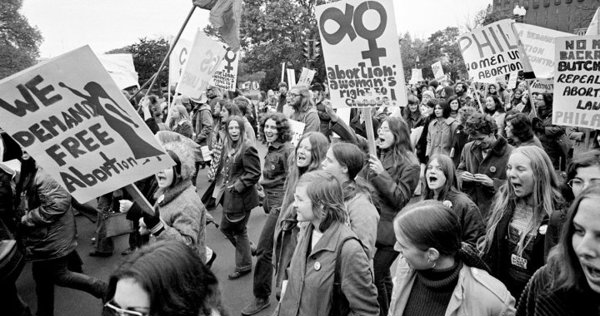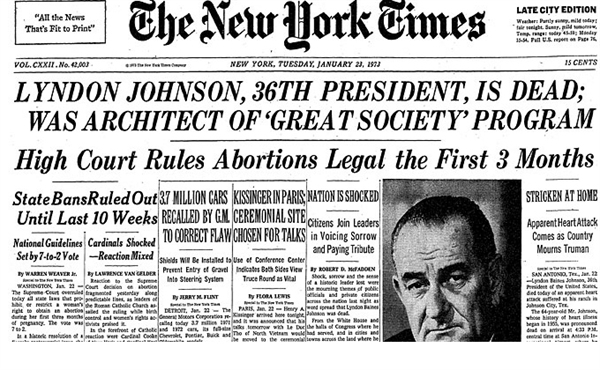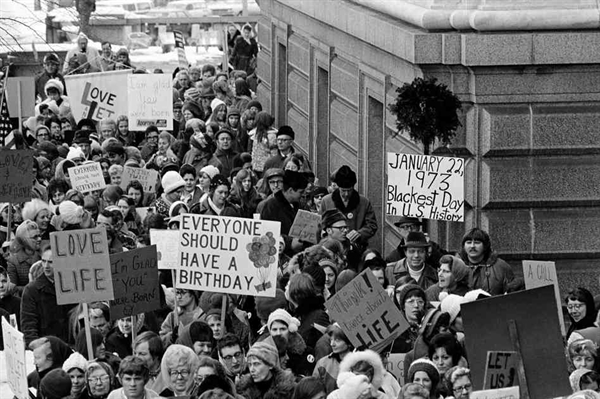Roe vs. Wade Day 2025 is on Wednesday, January 22, 2025: What were the details of the Roe vs Wade case?
Wednesday, January 22, 2025 is Roe vs. Wade Day 2025. Has Roe Been Good for Women? - Kristen Day - Red Letter Christians Roe V Wade

Roe v. Wade, 410 U.S. 113 (1973)[1], is a landmark United States Supreme Court decision establishing that most laws against abortion violate a constitutional right to privacy under the liberty clause of the Fourteenth Amendment, thus overturning all state and federal laws outlawing or restricting abortion that were inconsistent with the decision. It is one of the most controversial cases in U.S. Supreme Court history.
The decision in Roe v. Wade prompted national debate that continues to this day over whether terminating pregnancies should be legal (or more precisely, whether a state can choose to deem the act illegal), the role of the Supreme Court in constitutional adjudication, and the role of religious views in the political sphere. Roe v. Wade became one of the most politically significant Supreme Court decisions in history, reshaping national politics, dividing the nation into "pro-choice" and "pro-life" camps, and inspiring grassroots activism on both sides.
Critics describe Roe as illegitimate for straying from the text and history of the Constitution and imposing abortion policy on the states contra the American federalist system. Some critics of Roe also believe in the personhood of fetal human life.
Supporters describe Roe as necessary to preserve women's equality, personal freedom, and the primacy of individual rights, although the opposition to Roe often references the primacy of the individual when referring to the fetus.
History of cases
The case originated in Texas in March 1970 at the behest of young attorneys Linda Coffee and Sarah Weddington. They filed suit on behalf of Norma L. McCorvey ("Jane Roe") who claimed her pregnancy was the result of rape. McCorvey now says that her accusation was false, despite the fact that at one point in time, she went so far as to give a detailed account of her rape. Her alleged rape was not mentioned or used in the arguments for Roe v. Wade, as the attorneys had determined McCorvey's claims to be questionable.
A three-judge district court ruled in favor of "Jane Roe", but refused to grant an injunction against the enforcement of the laws.
Many advocates of liberalizing abortion laws saw promise in this line of cases, as abortion was widely proscribed by state laws at that time.
Both "Jane Roe" and defendant Wade arrived at the Supreme Court on appeal, where the case was argued by Weddington and Texas Assistant Attorney General Jay Floyd on December 13, 1971. The first argument of the case was unimpressive, however, and the resulting opinion, written by Justice Blackmun, was rather underwhelming. Furthermore, Justices William Rehnquist and Lewis F. Powell, Jr. had just joined the Court and hadn't heard the first argument. Chief Justice Burger proposed that the case be reargued, and the justices voted in favor. The case was reargued on October 11, 1972. Weddington continued to represent Roe, but Texas Assistant Attorney General Robert C. Flowers stepped in to represent Texas D.A. Wade.
Douglas threatened to write a dissent from the reargument order, but was coaxed out of the action by his colleagues; his dissent was merely mentioned in the order without further statement or opinion.
The court issued its decision on January 22, 1973, with a 7 to 2 majority voting to strike down Texas' abortion laws.
Roe established that abortion, under the United States Constitution, is a fundamental right, thereby subjecting all laws attempting to restrict it to the standard of strict scrutiny. Though abortion technically remains to this day a fundamental right, subsequent cases, notably Planned Parenthood of Southeastern Pennsylvania v. Casey and Stenberg v. Carhart, have modified the legal standard significantly.
The opinion of the Court, written by Justice Harry Blackmun, notes that "the restrictive criminal abortion laws in effect in a majority of States today are of relatively recent vintage" with criminalization of abortion mostly occurring from law enacted in the latter half of the nineteenth century. Section VI of the opinion was devoted to an analysis of historical attitudes, including those of: the Persian Empire, Greek times, the Roman era, the Hippocratic oath, the common law, English statutory law, American law, the American Medical Association, the American Public Health Association, and the American Bar Association.
Without finding a historical basis for the laws, the Court identified three justifications in Section VII of the opinion to explain the criminalization of abortion: (1) women who can receive an abortion are more likely to engage in "illicit sexual conduct", (2) the medical procedure was extremely risky prior to the development of antibiotics and, even with modern medical techniques, is still risky in late stages of pregnancy, and (3) the state has an interest in protecting prenatal life. As to the first, "no court or commentator has taken the argument seriously" and the statute failed to "distinguish between married and unwed mothers." However, according to the Court, the second and third constitute valid state interests. In Section X, the Court reiterated, "[T]he State does have an important and legitimate interest in preserving and protecting the health of the pregnant woman ... and that it has still another important and legitimate interest in protecting the potentiality of human life."
Valid state interests, however, must be weighed against the constitutionally protected rights of individuals in order to determine whether a law is a constitutional exercise of power. Even though the "Constitution does not explicitly mention any right of privacy" the court found support for a constitutional right of privacy in the First Amendment, Fourth Amendment, Fifth Amendment, Ninth Amendment, Fourteenth Amendment, and the penumbra of the Bill of Rights. The court found "this right of privacy" to be "broad enough to encompass a woman's decision whether or not to terminate her pregnancy."
However, the Court determined that "arguments that Texas either has no valid interest at all in regulating the abortion decision, or no interest strong enough to support any limitation upon the woman's sole determination, are unpersuasive." The Court declared, "We, therefore, conclude that the right of personal privacy includes the abortion decision, but that this right is not unqualified and must be considered against important state interests in regulation."
When weighing the competing interests the Court also noted that if the fetus was defined as a person for purposes of the Fourteenth Amendment then the fetus would have a specific right to life under that Amendment. However, given the relatively recent nature of abortion criminalization, the Court determined that the original intent of the Constitution up to the enactment of the Fourteenth Amendment in 1868 did not include the unborn. The Court's determination of whether a fetus can enjoy Constitutional protection is separate from the notion of when life begins. To that, the Court said, "We need not resolve the difficult question of when life begins. When those trained in the respective disciplines of medicine, philosophy, and theology are unable to arrive at any consensus, the judiciary, at this point in the development of man's knowledge, is not in a position to speculate as to the answer."
Relying on the current state of medical knowledge, the decision established a system of trimesters that attempted to balance the state's legitimate interests with the individual's constitutional rights. The Court ruled that the state cannot restrict a woman's right to an abortion during the first trimester, the state can regulate the abortion procedure during the second trimester "in ways that are reasonably related to maternal health," and in the third trimester, demarcating the viability of the fetus, a state can choose to restrict or even to proscribe abortion as it sees fit.
[edit] Justiciability
An aspect of the decision that attracted comparatively little attention was the Court's disposition of the issues of standing and mootness. The Supreme Court does not issue advisory opinions (those stating what the law would be in some hypothetical circumstance). Instead, there must be an actual "case or controversy", including particularly a plaintiff who is aggrieved and seeks relief. In the Roe case, "Jane Roe," who began the litigation in March 1970, had already given birth by the time the case was argued before the Supreme Court in December 1971. By the traditional rules, therefore, there was an argument that Roe's appeal was moot because she would not be affected by the ruling, and also that she lacked standing to assert the rights of pregnant women (other than herself) seeking an abortion. The Court concluded, however, that the case came within an established exception to the rule, one that allowed consideration of an issue that was "capable of repetition, yet evading review." Justice Blackmun's opinion noted that human pregnancy would normally conclude more quickly than an appellate process. "If that termination makes a case moot, pregnancy litigation seldom will survive much beyond the trial stage, and appellate review will be effectively denied." Such a ruling was critical to the Supreme Court's power to review the case, since the Supreme Court dismissed the physician James Hubert Hallford's intervention and affirmed the dismissal of John and Mary Doe.
Associate Justices Byron R. White and William H. Rehnquist wrote blistering dissenting opinions in this case.
"I find nothing in the language or history of the Constitution to support the Court's judgment," wrote Justice White. "The Court simply fashions and announces a new constitutional right for pregnant mothers and, with scarcely any reason or authority for its action, invests that right with sufficient substance to override most existing state abortion statutes. The upshot is that the people and the legislatures of the 50 States are constitutionally disentitled to weigh the relative importance of the continued existence and development of the fetus, on the one hand, against a spectrum of possible impacts on the mother, on the other hand. As an exercise of raw judicial power, the Court perhaps has authority to do what it does today; but, in my view, its judgment is an improvident and extravagant exercise of the power of judicial review that the Constitution extends to this Court.
"The Court apparently values the convenience of the pregnant mother more than the continued existence and development of the life or potential life that she carries. Regardless of whether I might agree with that marshaling of values, I can in no event join the Court's judgment because I find no constitutional warrant for imposing such an order of priorities on the people and legislatures of the States. In a sensitive area such as this, involving as it does issues over which reasonable men may easily and heatedly differ, I cannot accept the Court's exercise of its clear power of choice by interposing a constitutional barrier to state efforts to protect human life and by investing mothers and doctors with the constitutionally protected right to exterminate it. This issue, for the most part, should be left with the people and to the political processes the people have devised to govern their affairs."
Justice Rehnquist elaborated on this, saying: "The Court's opinion decides that a State may impose virtually no restriction on the performance of abortions during the first trimester of pregnancy . . . the Court uses her complaint against the Texas statute as a fulcrum for deciding that States may [p172] impose virtually no restrictions on medical abortions performed during the first trimester of pregnancy. In deciding such a hypothetical lawsuit, the Court departs from the longstanding admonition that it should never "formulate a rule of constitutional law broader than is required by the precise facts to which it is to be applied . . . the Court's sweeping invalidation of any restrictions on abortion during the first trimester is impossible to justify under that standard, and the conscious weighing of competing factors that the Court's opinion apparently substitutes for the established test is far more appropriate to a legislative judgment than to a judicial one.
"To reach its result the Court necessarily has had to find within the scope of the Fourteenth Amendment a right that was apparently completely unknown to the drafters of the Amendment. As early as 1821, the first state law dealing directly with abortion was enacted by the Connecticut Legislature. Conn. Stat., Tit. 22, §§ 14, 16. By the time of the adoption of the Fourteenth [p175] Amendment in 1868, there were at least 36 laws enacted by state or territorial legislatures limiting abortion.(1) While many States have amended or updated [p176] their laws, 21 of the laws on the books in 1868 remain in effect today.(2) Indeed, the Texas statute struck down today was, as the majority notes, first enacted in 1857 [p177] and "has remained substantially unchanged to the present time." Ante, at 119.
"There apparently was no question concerning the validity of this provision or of any of the other state statutes when the Fourteenth Amendment was adopted. The only conclusion possible from this history is that the drafters did not intend to have the Fourteenth Amendment withdraw from the States the power to legislate with respect to this matter."

What happened to make roe vs wade an issue and when did this happen?
Roe v. Wade, 410 U.S. 113 (1973)[1], is a landmark United States Supreme Court decision establishing that most laws against abortion violate a constitutional right to privacy under the liberty clause of the Fourteenth Amendment, thus overturning all state and federal laws outlawing or restricting abortion that were inconsistent with the decision. It is one of the most controversial cases in U.S. Supreme Court history.
The decision in Roe v. Wade prompted a still-continuing national debate over whether terminating pregnancies should be legal (or more precisely, whether a state can choose to deem the act illegal), the role of the Supreme Court in constitutional adjudication, and the role of religious views in the political sphere. Roe v. Wade became one of the most politically significant Supreme Court decisions in history, reshaping national politics, dividing the nation into "pro-choice" and "pro-life" camps, and inspiring grassroots activism.
Opposition to Roe comes primarily from those who viewed the Court's decision as illegitimate for straying too far from the text and history of the Constitution, and those possessing beliefs about the personhood of fetal human life.
Support for Roe comes from those who view the decision as necessary to preserve women's equality and personal freedom, and those who believe in the primacy of individual over collective rights, although the opposition to Roe often reference the primacy of the individual when referring to the fetus.
The case originated in Texas in March 1970 at the behest of young attorneys Linda Coffee and Sarah Weddington. Coffee and Weddington filed suit on behalf of Norma L. McCorvey ("Jane Roe") who claimed her pregnancy was the result of rape. McCorvey now says that she was lying, although at one point she went so far as to give a detailed account of her rape. Her (at the time) alleged rape was not mentioned or used in the arguments for Roe v. Wade, because the attorneys had determined McCorvey's claims to be questionable.
A three-judge district court ruled for "Jane Roe", but refused to grant against the enforcement of the laws.
Many advocates of liberalizing abortion laws saw promise in this line of cases, as abortion was widely proscribed by state laws at that time.
Both "Jane Roe" and defendant Wade appealed to the Supreme Court and the case was argued there by Weddington and Texas assistant attorney general Jay Floyd on December 13, 1971. Burger proposed that the case be put over for reargument, and the justices, unimpressed with the first oral argument in the case, underwhelmed by Blackmun's opinion, and wishing that new Justices William Rehnquist and Lewis F. Powell, Jr. participate, voted to reargue the case on October 11, 1972, at the behest of Chief Justice Burger. At the reargument, Weddington again represented Roe, while district attorney Wade was represented by Texas assistant attorney general Robert C. Flowers.
Douglas threatened to write a dissent from the reargument order, but was coaxed out of the action by his colleagues; his dissent was merely mentioned in the order without further statement or opinion.
The court issued its decision on January 22, 1973, with a 7 to 2 majority voting to strike down Texas' abortion laws.
Roe established that abortion, under the United States Constitution, is a fundamental right, thereby subjecting all laws attempting to restrict it to the standard of strict scrutiny. Though abortion technically remains to this day a fundamental right, subsequent cases, notably Planned Parenthood of Southeastern Pennsylvania v. Casey and Stenberg v. Carhart, have modified the legal standard significantly.
The opinion of the Court, written by Justice Harry Blackmun, notes that "the restrictive criminal abortion laws in effect in a majority of States today are of relatively recent vintage" with criminalization of abortion mostly occurring from law enacted in the latter half of the nineteenth century. Section VI of the opinion was devoted to an analysis of historical attitudes, including those of: the Persian Empire, Greek times, the Roman era, the Hippocratic oath, the common law, English statutory law, American law, the American Medical Association, the American Public Health Association, and the American Bar Association.
Without finding a historical basis for the laws, the Court identified three justifications in Section VII of the opinion to explain the criminalization of abortion: (1) women who can receive an abortion are more likely to engage in "illicit sexual conduct", (2) the medical procedure was extremely risky prior to the development of antibiotics and, even with modern medical techniques, is still risky in late stages of pregnancy, and (3) the state has an interest in protecting prenatal life. As to the first, "no court or commentator has taken the argument seriously" and the statute failed to "distinguish between married and unwed mothers." However, according to the Court, the second and third constitute valid state interests. In Section X, the Court reiterated, "[T]he State does have an important and legitimate interest in preserving and protecting the health of the pregnant woman ... and that it has still another important and legitimate interest in protecting the potentiality of human life."
Valid state interests, however, must be weighed against the constitutionally protected rights of individuals in order to determine whether a law is a constitutional exercise of power. Even though the "Constitution does not explicitly mention any right of privacy" the court found support for a constitutional right of privacy in the First Amendment, Fourth Amendment, Fifth Amendment, Ninth Amendment, Fourteenth Amendment, and the penumbra of the Bill of Rights. The court found "this right of privacy" to be "broad enough to encompass a woman's decision whether or not to terminate her pregnancy."
However, the Court determined that "arguments that Texas either has no valid interest at all in regulating the abortion decision, or no interest strong enough to support any limitation upon the woman's sole determination, are unpersuasive." The Court declared, "We, therefore, conclude that the right of personal privacy includes the abortion decision, but that this right is not unqualified and must be considered against important state interests in regulation."
When weighing the competing interests the Court also noted that if the fetus was defined as a person for purposes of the Fourteenth Amendment then the fetus would have a specific right to life under that Amendment. However, given the relatively recent nature of abortion criminalization, the Court determined that the original intent of the Constitution up to the enactment of the Fourteenth Amendment in 1868 did not include the unborn. The Court's determination of whether a fetus can enjoy Constitutional protection is separate from the notion of when life begins. To that, the Court said, "We need not resolve the difficult question of when life begins. When those trained in the respective disciplines of medicine, philosophy, and theology are unable to arrive at any consensus, the judiciary, at this point in the development of man's knowledge, is not in a position to speculate as to the answer."
Relying on the current state of medical knowledge, the decision established a system of trimesters that attempted to balance the state's legitimate interests with the individual's constitutional rights. The Court ruled that the state cannot restrict a woman's right to an abortion during the first trimester, the state can regulate the abortion procedure during the second trimester "in ways that are reasonably related to maternal health," and in the third trimester, demarcating the viability of the fetus, a state can choose to restrict or even to proscribe abortion as it sees fit.
[edit]
Justiciability
An aspect of the decision that attracted comparatively little attention was the Court's disposition of the issues of standing and mootness. The Supreme Court does not issue advisory opinions (those stating what the law would be in some hypothetical circumstance). Instead, there must be an actual "case or controversy", including particularly a plaintiff who is aggrieved and seeks relief. In the Roe case, "Jane Roe," who began the litigation in March 1970, had already given birth by the time the case was argued before the Supreme Court in December 1971. By the traditional rules, therefore, there was an argument that Roe's appeal was moot because she would not be affected by the ruling, and also that she lacked standing to assert the rights of pregnant women (other than herself) seeking an abortion. The Court concluded, however, that the case came within an established exception to the rule, one that allowed consideration of an issue that was "capable of repetition, yet evading review." Justice Blackmun's opinion noted that human pregnancy would normally conclude more quickly than an appellate process. "If that termination makes a case moot, pregnancy litigation seldom will survive much beyond the trial stage, and appellate review will be effectively denied." Such a ruling was critical to the Supreme Court's power to review the case, since the Supreme Court dismissed the physician James Hubert Hallford's intervention and affirmed the dismissal of John and Mary Doe.

how is the 14th amendment used in Roe vs. Wade?
Roe v. Wade, 410 U.S. 113 (1973)[1], is a landmark United States Supreme Court decision establishing that most laws against abortion violate a constitutional right to privacy under the liberty clause of the Fourteenth Amendment, thus overturning all state and federal laws outlawing or restricting abortion that were inconsistent with the decision. It is one of the most controversial cases in U.S. Supreme Court history.
The decision in Roe v. Wade prompted national debate that continues to this day over whether terminating pregnancies should be legal (or more precisely, whether a state can choose to deem the act illegal), the role of the Supreme Court in constitutional adjudication, and the role of religious views in the political sphere. Roe v. Wade became one of the most politically significant Supreme Court decisions in history, reshaping national politics, dividing the nation into "pro-choice" and "pro-life" camps, and inspiring grassroots activism on both sides.
Critics describe Roe as illegitimate for straying from the text and history of the Constitution and imposing abortion policy on the states contra the American federalist system. Some critics of Roe also believe in the personhood of fetal human life.
Supporters describe Roe as necessary to preserve women's equality, personal freedom, and the primacy of individual rights, although the opposition to Roe often references the primacy of the individual when referring to the fetus


